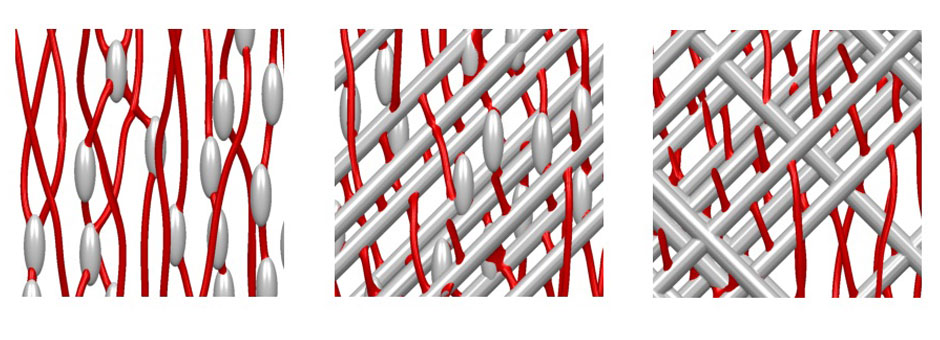
This snapshot of a simulation shows the defects in the material, here in gray, and pinning vortices, in red. The pinning enhances the superconducting behavior of the material at high magnetic fields. (Credit: Argonne National Laboratory)
High-temperature superconducting materials hold enormous promise for a variety of different applications because of their ability to transmit a current without any dissipation at relatively high temperatures—up to around 90 Kelvin (about -300° F), which permits cooling with liquid nitrogen.
However, this special ability decreases rapidly in the presence of a magnetic field, prohibiting their widespread use in superconducting motors and turbines.
This is because the magnetic fields, which penetrate the superconductor in the form of vortices, can move within the superconductor in the presence of an applied current. This causes a voltage drop across the superconductor, which in turn creates resistance. To counter this effect, one approach is to introduce defects into the superconductor to arrest vortex motion—or in other words, to “pin” the vortices in place.
In a new study, researchers at the U.S. Department of Energy’s (DOE’s) Argonne National Laboratory have developed a rational approach to optimize the arrangement of defects to enhance the current-carrying capacity of commercial high-temperature superconducting wires.
“You can think of the vortices as acting like marbles on a table, and the applied current as causing the table to tilt on one end, causing the marbles to slide,” said Ivan Sadovskyy, a joint Argonne/University of Chicago staff researcher and author of the study. Defects act as grooves and dents on this surface. “By putting a series of grooves in the material, we can trap the ‘marbles’ and arrest the motion of the vortices.”
In practice, these “grooves” include an assortment of different kinds of defects, such as chemical impurities that locally render the material nonsuperconducting or islands of nonsuperconductive materials.
“The ultimate goal of the research is to find a way to optimize the type, density and size of the defects to capture as many of the vortices as possible,” said Argonne materials scientist and study author Wai-Kwong Kwok.
The researchers used a synergistic approach that combined experiments with computer simulations carried out at the Argonne Leadership Computing Facility, a DOE Office of Science User Facility. Using time-dependent Ginzburg-Landau equations, a physical model describing the behavior of superconductors, the researchers were able to capture the dynamics of vortices, including their collective mutual interaction and pinning at defects. The computer simulations based on these equations delineate the motion of the vortices as they approach a defect, get pinned there and eventually separate from the defect when the current gets too high.
These equations, when coupled with information gathered from experiments, enable scientists to design predictive strategies for inducing optimal defects into commercial superconductors. For example, the researchers generally found that multiple smaller defects were more effective than larger ones designed to capture multiple vortices at once. They also discovered that defects can interact with each other in a way that is not purely additive—more defects do not always translate to higher current carrying capacity.
Too many defects will reduce the fraction of material that is superconducting. Too few defects will only pin a small number of vortices. Furthermore, as the researchers discovered, different types of defects could introduce new pathways for vortex motion instead of pinning them.
“Just like many problems in science, you have to find a balance,” Sadovskyy added. “And there’s definitely a bit of guessing and checking to find the optimal arrangement.”
The team’s groundbreaking results are published in a series of recent papers: “Toward superconducting critical current by design” (Advanced Materials, March 31, 2016); “Simulation of the vortex dynamics in a real pinning landscape of YBa2Cu3O7−δ coated conductors” (Phys. Rev. Applied 5, 014011, 2016); and “Optimization of vortex pinning by nanoparticles using simulations of time-dependent Ginzburg-Landau model” (Phys. Rev. B 93, 060508, 2016).




